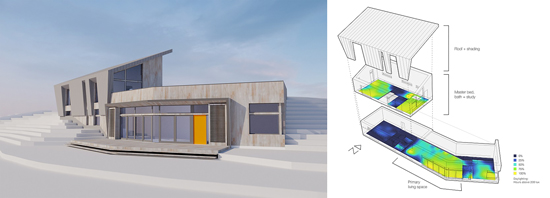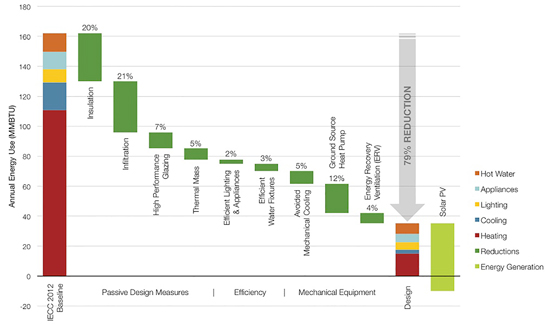Performance Matters!
Performance in the Early Design Process
As seen in some of the examples we have looked at already, performance-based design is most effective when it is used from the outset during the early design stages of a project. A building’s performance relative to resource use, occupant comfort, and environmental impact can be heavily influenced during the conceptual and schematic design phases. Designers who fail to consider performance during these earliest stages of design often miss significant opportunities to deliver high-performing and exceptional designs. Further, early analysis and collaboration significantly reduce the risk of missing performance targets and therefore reduce the risk of expensive rework. At this stage, the primary benefit is in performing comparative analyses between different building-massing concepts or building envelope strategies.
In early design, implicit decisions about building performance are being made with every design choice. Therefore, having quick and easy feedback on the performance impacts of those design choices is invaluable. For example, a building shape that increases the overall exterior wall area will be subject to more thermal exposure than a design that is geometrically more efficient. PBD software linked with design software is incredibly useful at identifying how much of an impact that difference makes in the conceptual stage of building design. Basically, it allows architects and other design professionals to move fluidly and fast to bring fundamental ideas to life while seeing the impacts of the choices made.
Using a Single Design and Performance Model
The benefits of starting from the outset with PBD have been fully realized by Sterner Design, an architectural design and consulting practice dedicated to creating a truly sustainable built environment. A recent project of the firm was a net zero energy single-family residence in Iowa with 2,400 square feet and two stories using partial underground or earth bermed construction. The firm started design from the beginning by creating a 3-D computerized model using available software with PBD software added on. The beauty of this approach is that the same model was used, developed, and refined throughout the entire project for design, presentation, documentation, and analysis. In this case, there was never a need to create any separate models or prepare separate drawings other than those that were extracted directly from the same model all the way through.

Photo courtesy of SketchUp
Sterner Design used a single computer model beginning in early design all the way through the design process to create a net zero energy, well daylit, partially underground residence in Iowa.
The firm’s first performance investigation focused on how to achieve good daylight in a house that is partially underground. Carl Sterner, lead designer and principal of Sterner Design, approached daylight from an experiential point of view. The goal was to achieve 200 lux (typical light level for a residence) through daylight alone for at least 60 percent of the year in the primary living areas: living room, dining room, kitchen, and study. In addition, the design needed to ensure good daylight distribution across these spaces to avoid uncomfortably bright and dim areas, despite having windows primarily on one orientation.
Computerized daylight analysis was used in the earliest design phase of the project to investigate the impact of different conceptual design options on daylight penetration and distribution across the home. Designs were not necessarily ruled out due to poor performance; instead, the analysis was used to understand what mitigating steps would need to be taken if these designs were pursued. Options with a narrow floor plate (20 feet or less) were ideal from a daylighting standpoint; deeper floor plates would require more creative (and perhaps expensive) solutions such as skylights.
In addition to daylight, the goal was to reduce overall energy use to the point where the remaining needs could be reasonably generated on-site. However, Iowa, like much of the American Midwest, poses a difficult climatic challenge. With a mixed climate, it is very cold in the winter but quite hot and humid in the summer. To reduce energy use, proposed strategies needed to keep both cooling and heating requirements in balance. Following several design iterations, the team arrived at a concept that combined daylight and energy performance with the client’s requirements and budget. At this stage, PBD analysis was used to further refine the design and address potential problem areas. By combining both passive strategies (natural ventilation, an optimized building envelope, and shading devices) and efficient mechanical systems (ground-source heat pump and energy-recovery ventilation), Sterner was able to achieve a 79 percent reduction in energy use compared to the code baseline and meet the targeted on-site energy budget. To offset the remaining energy use and achieve net zero energy status, the design incorporates roof-mounted solar photovoltaic panels on the large south-facing roof.

Photo courtesy of Sefaira
Performance-based design used in the earliest design stages helped architects understand how to reduce the energy requirements on a custom residential project by 79 percent, making on-site solar electric generation viable.
Notice

www.sefaira.com

www.SketchUp.com









